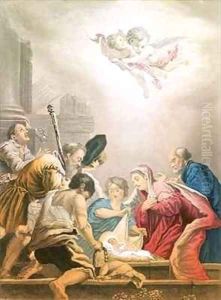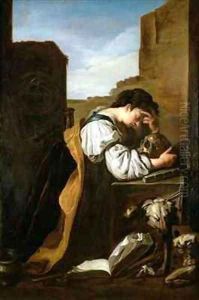Fetti or Feti, Domenico Paintings
Domenico Fetti, also known as Feti, was an Italian Baroque painter who was born in Rome in 1589. He was a significant figure in the transition from the Renaissance to the Baroque style of painting. Fetti's work was characterized by his dynamic compositions, vibrant use of color, and the emotional intensity of his figures. Despite his relatively short life, he left a considerable impact on the development of Baroque art, particularly in the region of Venice.
Fetti received his initial training from his father, Pietro Fetti, who was a painter and picture dealer. Later on, he became a pupil of Ludovico Cigoli, a prominent artist of the time. Fetti's early works demonstrate the influence of his teacher as well as that of the Mannerist style, which was prevalent during his formative years. However, as his career progressed, he began to develop a more individual style that broke away from the rigid formality of Mannerism towards a more expressive and naturalistic approach.
In 1613, Fetti moved to Mantua, where he entered the service of Ferdinando Gonzaga, Duke of Mantua. It was here that he began to flourish, receiving numerous commissions from the duke and other patrons. One of his most notable projects was a series of parables for the duke's studiolo, which showcased his skillful storytelling and innovative use of allegory. These works were instrumental in spreading his reputation beyond Mantua.
Fetti's art was marked by his distinctive brushwork and his ability to capture the psychological depth of his subjects. He was particularly adept at depicting the textures of materials and the play of light on surfaces, which added a sense of realism to his paintings. The influence of Venetian artists, particularly Jacopo Tintoretto and Titian, is evident in Fetti's work, particularly in his vibrant color palette and the atmospheric effects he achieved.
In 1622, Fetti left Mantua for Venice. His move coincided with a period of personal turmoil, as he suffered from ill health and financial difficulties. Nonetheless, his arrival in Venice was timely, as the city was a vibrant center of artistic innovation. Here, Fetti's style continued to evolve, and he produced some of his most celebrated works, including portraits and religious scenes that reflect a mature mastery of his craft.
Unfortunately, Domenico Fetti's promising career was cut short when he died in Venice in 1623, at the age of 34. Although his life was brief, his influence on Baroque painting was significant, with his dynamic compositions and expressive style leaving a lasting impression on subsequent generations of artists. Today, Fetti's paintings can be found in major museums around the world, where they continue to be admired for their emotional power and artistic ingenuity.

